22 technology ideas that promise to change the future
- Tram Ho
Hand-guided robot
A student at Loughborough University (UK) recently successfully designed a prototype of a hand-guided robot to help guide the visually impaired with the same working principle as a guide dog.
Products created by students of the Industrial Design Department are programmed for safe and fast use by continuously collecting real-time data.
This device called Theia is a handheld device that can guide the environment in an external environment with very simple usage. Users simply say the destination, the device will guide the way in the same way as the car navigation system.
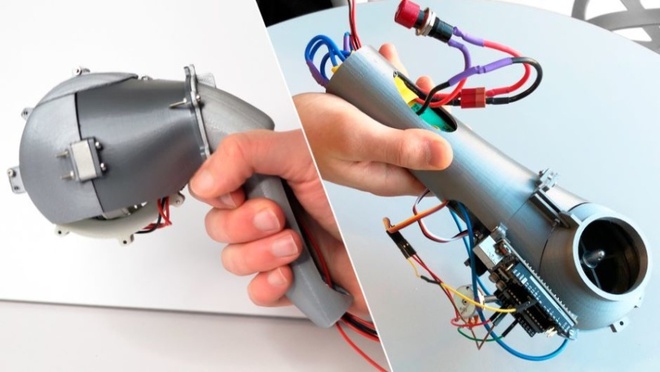
This device is like a lightweight handle.
For high-precision operation, Theia uses a special gyroscope that combines a camera system to reconstruct a 3D image of the environment, like a self-propelled vehicle. When the user orders, the device will collect external information in combination with real-time data processing on traffic, weather to determine the safest destination.
Theia will automatically activate unsafe situations when there is a dangerous situation such as crossing a lot of traffic. When it does, it will return to manual mode, acting as a guide stick.
Watches run by sweat
Engineers from Glasgow University (UK) have successfully developed a new type of supercapacitor that can store energy with sweat, replacing electrolytes in conventional batteries.
This super capacitor can be fully charged with only 20 mL of solution and is strong enough to operate on a 4,000-charge charge cycle under bended usage.
The device works by coating a synthetic layer of polyester cellulose on a thin polymer layer, acting as an electrode of a super capacitor.
 This invention can be applied in sport activities. |
| The cloth will absorb the wearer’s sweat, while the positive and negative ions in the sweat will interact with the polymer surface to create an electrochemical reaction and then generate energy. |
Currently, the technology only submits patents and has not yet released a specific product, but Professor Ravinder Dahiya, the project’s leader, places great hopes on its potential thanks to its ability to protect the environment and not harm it. human skin.
Live concrete restores itself
Fresh concrete is a ready-mixed concrete, it is a mixture of sand, gravel, cement and water mixed in a certain proportion. But scientists at the University of Colorado Boulder (USA) have successfully developed a special type of concrete, a mixture of sand, gel and bacteria, which they call concrete.
 The team leader, Wil Srubar, was holding live concrete. |
| Research shows that the new material is able to withstand the load and is especially self-healing from fractures. Of course, fresh concrete is far more environmentally friendly than conventional concrete, the most consumed material on Earth after water. |
Scientists are confident that the material could pave the way for future construction with the ability to recover itself, absorb dangerous toxins in the air and even discolor, a characteristic on bacteria that Need more time to research.
Micro live robot
Just like the idea above, this is really not a robot but a living structure. Scientists at the University of Vermont (USA) have created a completely new life form from the living cell structure taken in frog embryos.
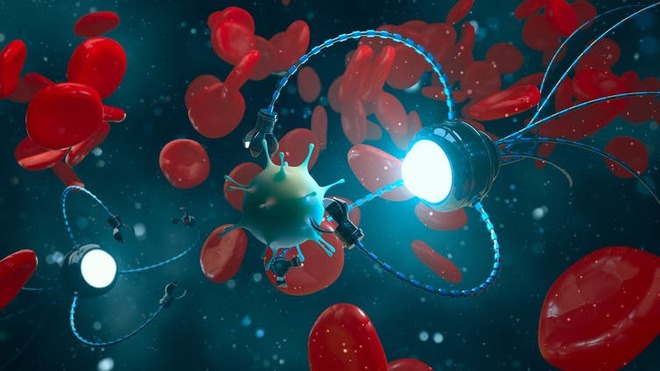 Robots at the cellular level are expected to help humans perform micro jobs. |
| Named as xenobots, it is able to move towards the target and heal itself after being cut. “They are incredible living machines,” said project leader Joshua Bongard. |
They cannot be considered traditional robots or an animal. It is an artificial life that can be programmed, according to him. Scientists believe that this living robot could be useful for finding sources of radioactive contamination, collecting contaminated plastic particles from the ocean and entering arteries to heal wounds.
Virtual reality enhances touch
Researchers at Northwestern University in the US have successfully developed a sample device capable of emitting tactile signals using a material with micro-vibrating particles attached to the skin.
The device, temporarily called epidermal VR, can be used to send intimate touches of a child in daycare to a distant parent or give an impression of touching objects to the disabled.
With the game industry, it can create a corresponding warning on parts of the body when the player controlled character is attacked in different positions.
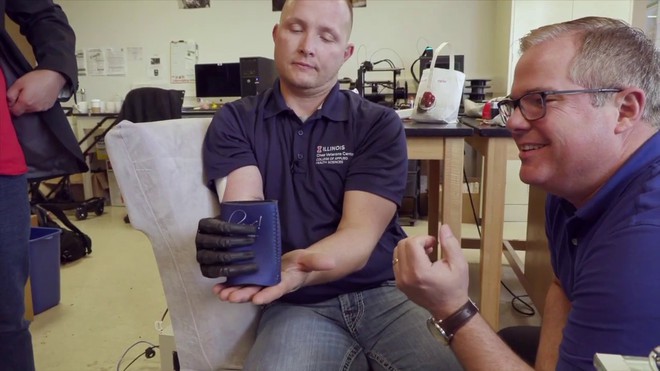 Augmented reality virtual reality device helps bring the feeling of holding objects to the disabled. |
| The team created a device that consists of 32 vibration points mounted on a 15 cm x 15 cm silicone polymer sheet, to stick to the skin without tape, straps or batteries or wires. |
The device uses NFC technology to transmit data. This is a short-range wireless connection technology that is widely used in mobile payment on smartphones today.
The researchers hope that the aforementioned VR epidermis device can be developed into clothing, thereby helping those using prosthetic limbs can wear the device to make them feel more realistic.
Internet for everyone
Today, it’s hard to live and work without an Internet connection. However, it is a fact that about half of the world’s population does not have the Internet for objective reasons.
This situation has led some technology giants to embark on great projects for mankind. Google is slowly sending ‘super huge’ Internet balloons to remote areas while Facebook has plans to use drones to provide the Internet to remote areas.
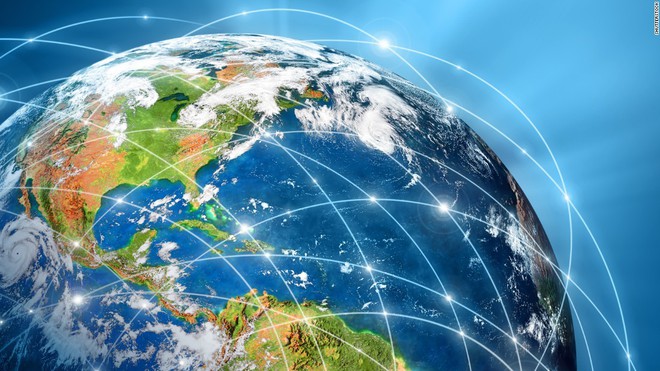 |
Most recently, we have SpaceX and Amazon with projects that provide the Internet to humanity using artificial satellites. While Elon Musk is ambitious to launch about 42,000 satellites, Jeff Bezos plans to put about 3,236 small satellites into Earth’s low orbit.
A Dutch startup, Hiber, has successfully launched two satellites into orbit to provide Internet connectivity for Antarctica.
Shirt monitor heart rate
Heart rate sports watches are not a new idea, but research shows that the accuracy of these devices varies quite erratically. For ordinary people, you simply want to know the number of calories consumed, but for experts, they need to be more accurate.
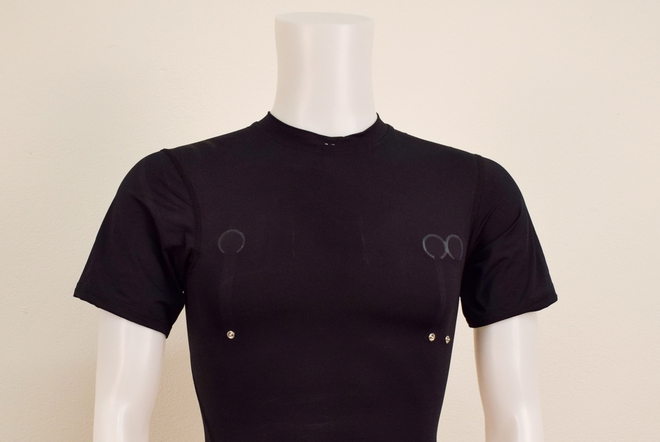 Shirt measure heart rate and send data to the cloud. |
| Using a single ECG to print on shirts, the new Kymira-developed shirt can accurately measure heart rate and send data to the cloud via Bluetooth connectivity. Once the data is sent, the algorithm accurately identifies the wearer’s heartbeat abnormalities. |
Kymira founder and CEO Tim Brownstone intends to develop this product for clinical use in people with a history of cardiovascular disease, thereby issuing timely warnings as soon as signs of illness appear.
Reuse coffee grounds
The effects of the Covid-19 epidemic could lead to a decline in global coffee consumption, for the first time since 2011. However, the amount of coffee consumed each year is still extremely large, reaching millions. tons, which means the same amount of waste coffee grounds.
 The lumps of coffee charcoal are used as household fuel or in light industry. |
| English businessman Arthur Kay founded the green startup with the idea of reusing coffee. Initially, the company used it as a biofuel but could not be commercialized. Now the company is shifting to recycling coffee into solid fuel for burning with lower emissions than firewood. |
Sound extinguisher
Extinguishing fires in nature is not easy, due to the large difference between the area of the fire and the fire tools. Most notably, a wildfire earlier this year in Australia killed 1 billion animals, according to estimates by biologists at the University of Sydney.
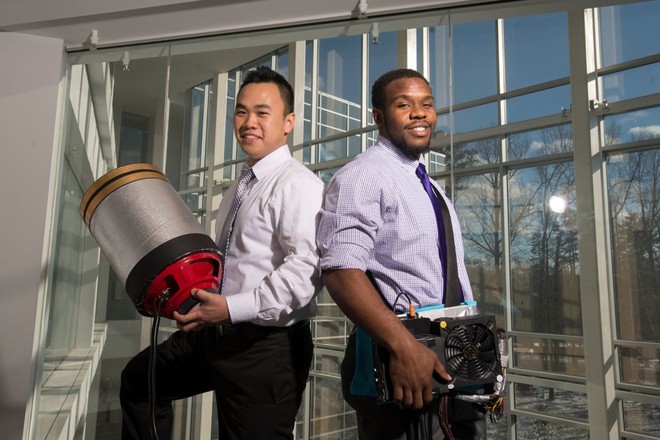 Viet Tran and his associates were holding an audio fire extinguisher. |
| Natural disasters can be solved neatly if one day, humans can use drones to extinguish fires by sound, based on patents of two students of George Mason University (USA), Seth Robertson and Viet Tran. |
By creating bass at frequencies from 30 to 60 Hz, cutting off the external oxygen supply for the fire, Seth and Viet have successfully built an audio extinguisher to extinguish a small fire immediately. .
Recently, the two had a public fire performance at the invitation of Mr. Reinette Senum, Nevada City Market. They also partner with Arsac Technologies to commercialize products in the near future.
AI does the work of the scientist
Planaria is a tiny worm that has an intense vitality. Cut off their heads and they will grow new with old memories. Cut in half and two worms will be born. Radiating radiation into them will heal itself.
For years, scientists have been puzzled about the secret of this strange worm. But only took 42 hours, a machine at Tufts University (USA) analyzed and solved the conundrum about the ability of the worms to regenerate themselves.
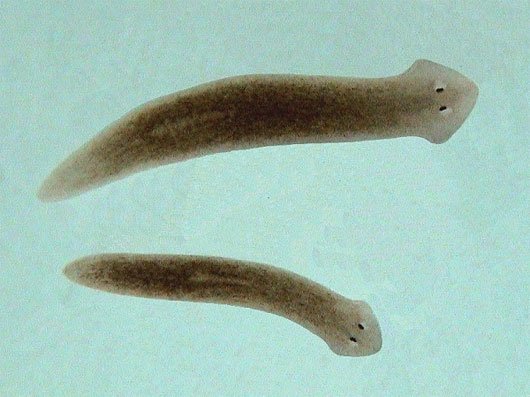 Planaria is a worm that lives like a leech. |
| Although AI must be provided with sufficient information, called machine learning, to solve tough problems, the way Tufts University’s AI creates abstract theory independently is still a big step for the Development of computer consciously and the research potential of AI. |
Space balloon
Hot air balloons are a great way to see the scenery, if you are not afraid of heights. But if you want to see the Earth at a higher altitude than that, using a space balloon is a solution for you.
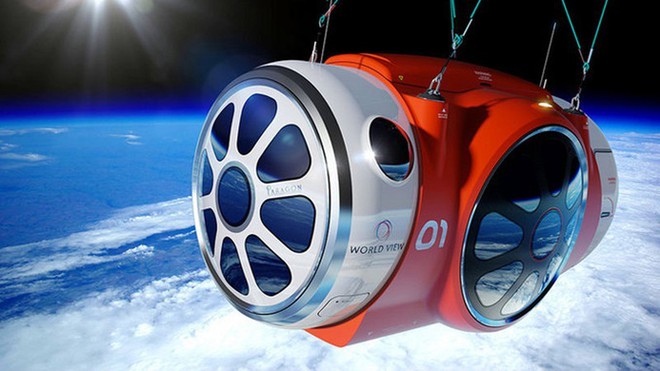 Visiting Earth with a hot air balloon is entirely possible. |
| The company, called World View Enterprises of the United States, has launched a solution to explore the universe with a hot air balloon since its inception in 2013. But it was only in June that they had a test flight. success. |
This space balloon will take visitors up to 32km above sea level, high enough for you to see the edge of the Earth from space for a few hours, before letting guests parachute down. The cost for such a trip is USD 75,000 per person on an 8-seat flight.
Smart needle detects cancer
A smart needle has been developed by scientists in the UK, helping to speed up cancer detection and diagnosis.
The researchers believe the technology could help in diagnosing lymphoma, reducing patients’ anxiety while waiting for test results. Currently, people suspected of having lymphoma must have a tissue sample, lymph node biopsy to get an accurate diagnosis, which takes a lot of time.
The needle, which uses a technology called Raman spectroscopy, shines a low-power laser onto a suspected cancerous body, with the potential to detect the disease in seconds, scientists at the University of Exeter said. .
“Raman’s smart needle can measure the molecular changes associated with tissue and cell disease at the tip of the needle. From there we can determine if the patient is healthy or not, ”said project leader Professor Nick Stone.
Antibiotic resistant bacteria in seawater
This is a project that the Surfers Against Sewage (SAS) has cooperated with Exeter University’s School of Health through researching beachgoers throughout the summer, called Beach Bums. .
Specifically, SAS believes that these people may accidentally ingest seawater containing antibiotic-resistant bacteria during surfing. The project is still calling on volunteers to be tested to determine whether or not the virus exists in the rectum, as well as finding a way to kill them.
Fully charge the electric vehicle battery within 10 minutes
One problem with electric vehicles is that the number of charging stations is sufficient and the charging time is fast enough so that drivers do not have to wait long or not.
Fast-charging technology has partly solved that conundrum, but it has been shown by researchers at Pennsylvania State University that will shorten battery life. This happens because the flow of lithium particles means ions moving at low temperatures between partially held electrodes, called lithium plating.
 |
The solution is to raise the battery temperature to about 60 degrees Celsius for about 10 minutes and then quickly cool to ambient temperature, the lithium spikes will not form and therefore the battery will not bottle. The battery design will add a thin piece of nickel to create a circuit that will heat up in less than 30 seconds inside the battery. The car cooling system will then cool down the battery.
According to the research, this technology can fully charge a small electric car in just 10 minutes.
Smart shelf
Expired foods are hard to distinguish from the naked eye. There are even foods that spoil before they expire due to an error in the packaging process or due to improper storage.
The expiry date is therefore something that protects manufacturers from getting involved in a lawsuit, but it does not help users know exactly what happens inside the packaging.
 Smart expiry date is posted on food packaging. |
| A PhD student at Brunel University found a solution to this conundrum, using an intelligent shelf called Bump Mark. The patch is made up of four layers to create a sense of smoothness when touched. But when its surface becomes rough, it also signals that the food inside has expired. |
The principle of this shelf-life is to use gelatine, a protein-rich solid that will liquefy at the same rate of decomposition of food. Currently the research is still in the process of waiting for a patent
Self-propelled truck
Unmanned cars have been a long-held idea. And now is the time for manufacturers to think of more distant ideas like driverless trucks and applications in logistics.
Indeed, if it is possible to build a self-driving truck chain, transport businesses can cut costs, increase the number of trips, optimize the distance, and transport 24/7 continuously through which Chemistry circulation faster with cheaper costs.
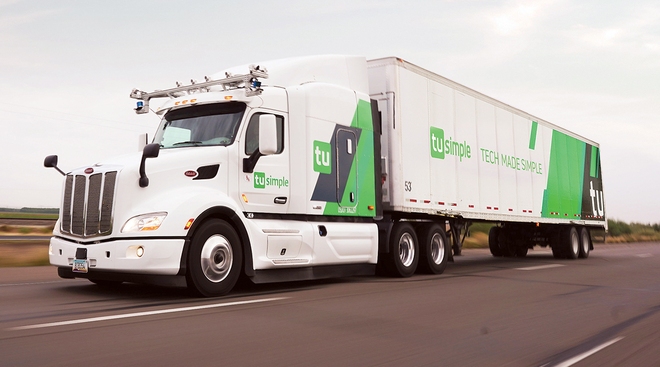 TuSimple self-propelled truck model. |
| Most recently, TuSimple has successfully cooperated with the US Postal Service to transport parcels by self-propelled trucks. The unicorn startup also plans to produce self-driving trucks across the United States with a vision to 2024. |
If the plan is successful, transportation companies can upgrade the entire fleet in just one night. Drivers will lose their jobs and even toll station employees. Even so, transport companies still need an inventory of vehicles to ensure the goods are safely protected.
Remove cheap tattoos
Tattoos today are no longer something too terrible for society. However, when you regret your tattoos and want to delete them, the only way is to use laser beams on expensive, painful but actually only blur the tattoo.
A PhD student in Canada named Alec Falkenham has devised a way to remove cheap tattoos by using the body’s own immune system. He developed a cream that contains a special compound that, when applied to the skin, reverses the tattooing process.
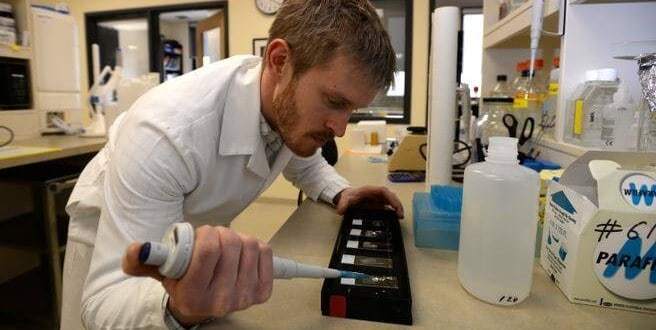 Alec Falkenham works in a laboratory at Dalhousie University (Canada). |
| Specifically, tattooing is the process of injecting ink through the epidermis into the dermis, causing the body’s immune response. To clean the dermis, the body dispatches macrophages to surround and attack the squid. However, when the attack is complete, the macrophages remain in their state, creating a permanent tattoo on your body. |
This cream was tested on pigs and mice at a cost of only about $ 4.5 for a 20 square centimeter tattoo. But it will take a lot of time for clinical trials in humans and for approval by the US Food and Drug Administration (FDA), an estimated process that takes 10-15 years.
Artificial neuron chip
A team of researchers at the University of Bath (UK) has successfully fabricated nerve cells based on a chip, which accurately simulates the conductivity and activity of neurons in the nervous system.
The head of the project, Professor Alain Nogaret, is quite optimistic about the potential of this chip. “The neurons are like a black box up to now, but we were able to open the box and look inside it. Our job is to transform the model because it provides a very powerful way to copy the electrical conductivity of real neurons in very detailed detail. But it is even wider, because the human neuron needs only 140 nW of power, which is only 1/1 billion of the power consumed by a CPU. ”
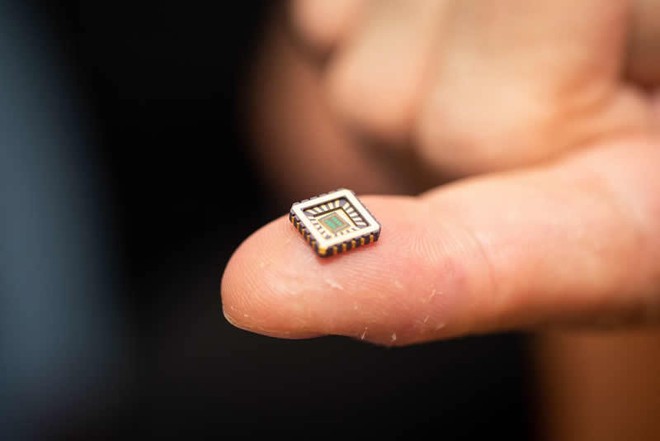 |
The study opens up the possibility of biological transplantation to replace damaged neurons in diseases such as Alzheimer’s. Another possibility that the team expects is that artificial neurons can regulate the heart rate by modulating the response from the nervous system, thereby eliminating diseases like heart failure.
Smart floating farm
The United Nations projects that the world will have 2 billion more people by 2050, leading to a 70% increase in food demand. At that time, people living in the city will account for 80% with the majority of food and food brought in from outside.
How to solve the food problem when land fund is increasingly limited? Architect Javier Ponce introduced the idea of a three-storey structure with each 24m high floor placed solar panels on the roof, planned in Singapore.
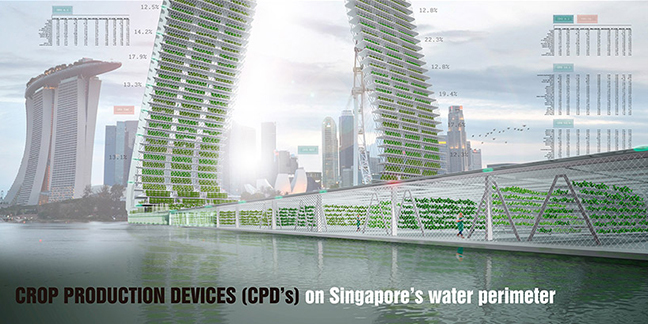 Floating farm model of Javier Ponce |
| The middle floor of this architecture will grow a variety of vegetables on an area of about 51,000 square meters, not grown on soil but in liquid containing nutrients. The excess of nutrients and plants in the middle layer will fall to the bottom floor, in an enclosed space rearing fish. |
With an intelligent floating farm with an area of about 350 x 200m, it is estimated that it can produce about 8.1 tons of vegetables and 1.7 tons of fish per year. In particular, the design of a farm near the city will be very convenient for transportation if you do not know that Dubai must import up to 11,000 tons of fruits and vegetables … every day.
4-week workweek
Just a few seconds of searching, you will see many results showing that working less effectively bring more, according to independent research from many scientists from England, USA.
According to these studies, lesser workweeks have been shown to encourage employees to stay longer, more productive. A shorter working week will also significantly reduce the travel of people, thereby reducing global emissions.
 |
If you’re wondering when you can work only 4 days a week, New Zealand Prime Minister Jacinda Ardern probably has the answer. In May, Ardern urged businesses to work for workers only four days a week due to the impact of Covid-19, to stimulate tourism and balance their lives.
Perpetual Guardian Company in New Zealand also applies the policy of making 4 days / week permanently since 2018.
Ice Age Park
A team of Russian scientists is hoping to successfully replicate the 12,000-year-old habitat of prehistoric animals such as mammoths, fluffy rhinos and elk. The project was named Pleistocene Park (an Ice Age memorial) in a 160-square-kilometer reserve on the Kolyma River in the Siberian steppe of Russia.
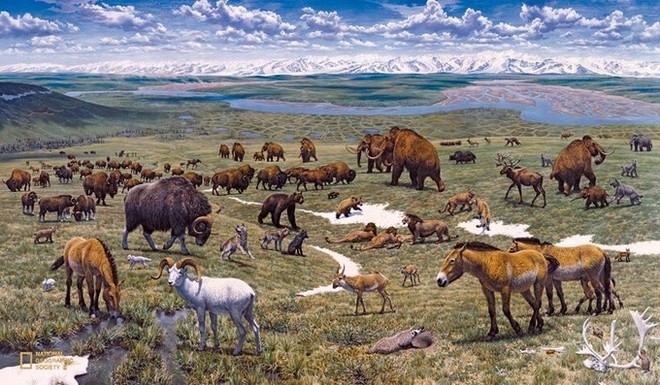 |
Not only have the ambition to recreate habitats for prehistoric giant animals, scientists believe that increasing the number of animals in Siberia will help prevent global warming by prolong the existence of eternal ice here.
Super perfect material
What is mentioned here is Aerogel, a gel that is not a liquid but exists as a gas. It has been around since 1931, but it is only recently that humans have found a way to make Aerogel affordable and non-toxic.
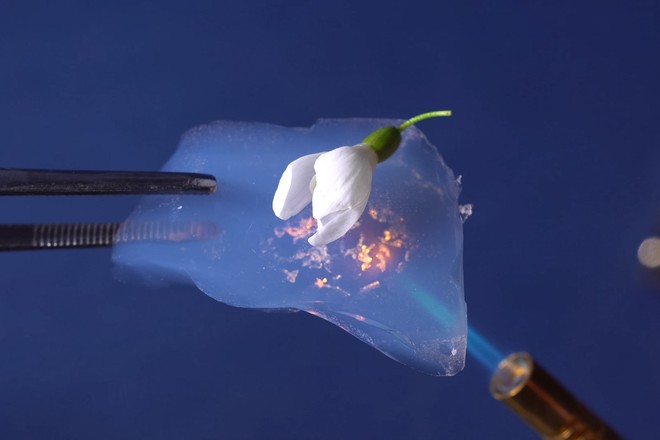 |
| Aerogel is like a piece of air, light and heavy. |
Aerogel is a solid but super lightweight solid, containing 95% of microscopic pores with diameters from 20nm to 50nm, so that gas molecules cannot pass through. This material is both insulating and insulating, but can absorb both oil and water.
With its light weight and heavy load, Aerogel is now widely used in aerospace. The biggest obstacle nowadays is the production cost per 0.45kg Aerogel up to 23,000 USD.
According to Sciencefocus
Source : Genk
